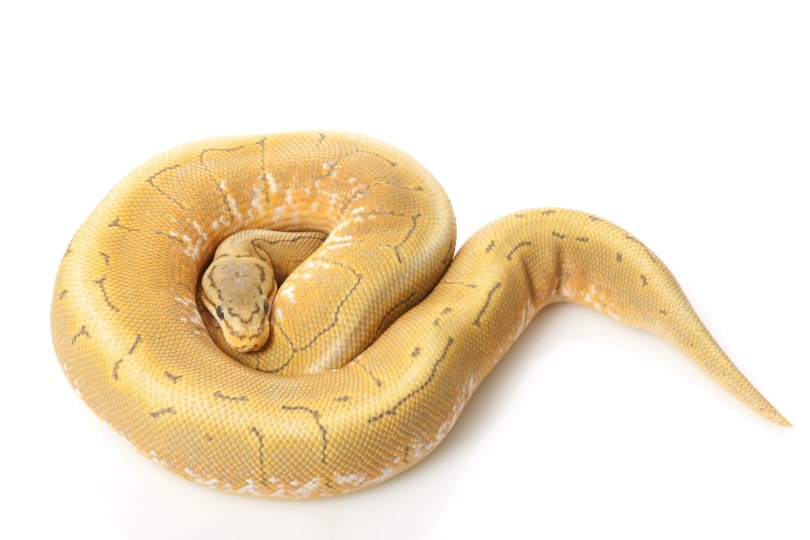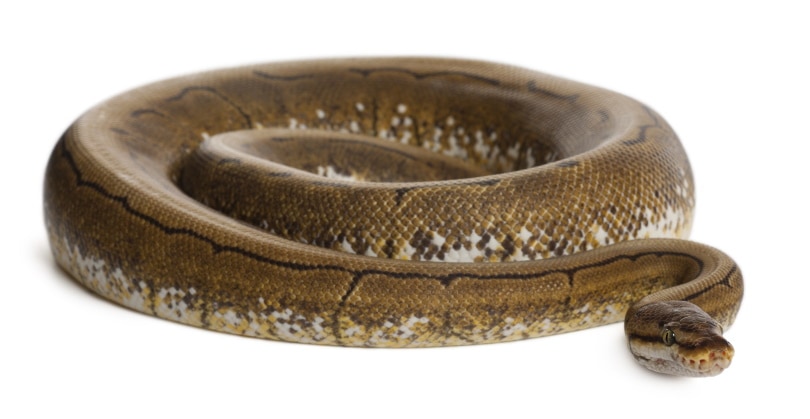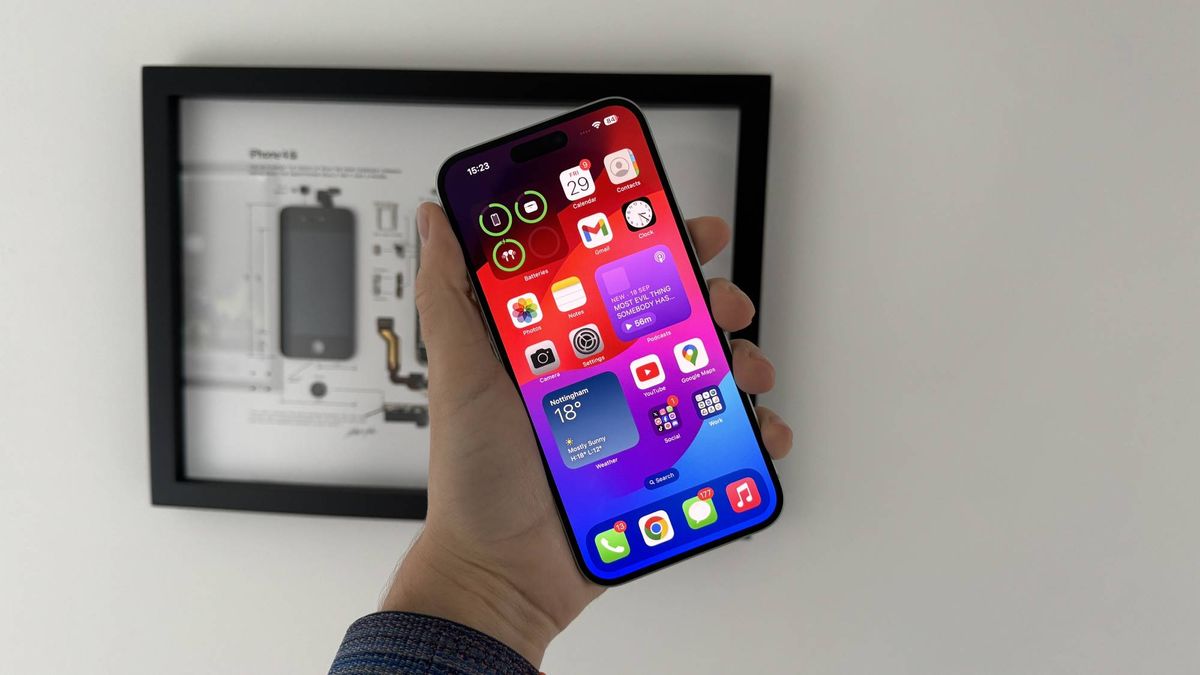

The Ball Python is one of the most popular pet pythons in the United States. While they are a bit shy, their smaller size and friendly nature also make them easier to care for. They don’t require extensive care and can be kept for pretty cheap.
The Spinner Ball Python has a bright yellow coloration that is the result of mixing the pinstripe and spider genes. This coloration is unique and can vary from snake to snake.
Quick Facts about the Spinner Ball Python
| Species Name: | Python regius |
| Common Name: | Ball Python |
| Care Level: | Low |
| Adult Size: | 3 to 5 feet |
| Diet: | Rats |
| Minimum Tank Size: | 36-inch by 18-inch by 12-inch |
| Temperature & Humidity: | 78 to 96 degrees; 50% to 60% humidity |
Do Spinner Ball Pythons Make Good Pets?

These snakes are often considered the best option for beginners. They are quite laidback and easy to care for. Their smaller size means that they take up less room, which makes them better for smaller spaces as well.
The Ball Python is simply more agreeable than most snakes, making it a good choice for those without much experience.
Appearance
The Spinner Ball Python features a bright yellow, brown, and black coloration. They have both the pinstripe and spider ball genes, which give them a unique look. These pythons are rarer than other options, which also makes them more expensive.
Besides their unique morph, these snakes look and act the same as all other ball pythons. They usually reach a maximum of 3 to 5 feet – a smaller size than most other python species.
How to Take Care of Spinner Ball Pythons
Habitat, Tank Conditions & Setup
Tank
These snakes do best in an enclosure with a solid top, as this helps promote the correct humidity. Fish tanks can be useful for this purpose. You can also use many commercially available snake tanks.
Smaller, younger snakes do better in smaller enclosures. Adult ball pythons usually don’t need very big enclosures, though. Typically, a 36-inch by 18-inch by 12-inch tank is plenty big enough for most snakes. Hide boxes are a good choice for these snakes as well since they are on the shier side.
You should spot-clean your snake’s tank daily. Using a specialized cleaner is often necessary, as normal cleaners are not safe for most snakes. Every 30-days, you should completely remove and clean everything in the tank.
Lighting
You should aim for your snake’s tank to have a cool corner on one end and a warmer corner on the other. Heat lamps are sometimes recommended, but you can just as easily use heat pads and similar devices to keep the snake at the proper temperature.
Heating bulbs will dry out the air faster than other heating methods, so using them requires keeping an extra eye on the tank’s humidity. Supplemental lighting is not necessary.
Heating (Temperature & Humidity)
The basking area of your snake’s enclosure sold to be at 88 to 96 degrees Fahrenheit. The ambient temperature should be around 78 to 80. It is vital that the temperature is correct, so we do recommend monitoring it with the appropriate thermometers.
Substrate
Newspapers and paper towels are often the most recommended substrates for ball pythons. They are cheap and very easy to clean. You simply remove the old paper and switch it with new paper. Cypress mulch and orchid bark can be used as well.
Tank Recommendations
| Tank Type: | 36-inch by 18-inch by 12-inch |
| Lighting: | Optional |
| Heating: | Heating pad, tape, rocks, etc. |
| Best Substrate: | Paper |
Feeding Your Spinner Ball Python
Your young python should be fed a rodent weekly, while adults can eat every 1 to 2 weeks. These should be no bigger in circumference than the ball python is. Otherwise, they will have a hard time eating it. Don’t handle your snake for at least a day after feeding them, as this can mess with their digestion.
They can be given thawed and pre-killed rodents. Live rodents can injure the snake and are not recommended.
It is normal for snakes to go months without eating. This is especially true during the winter months.
Diet Summary
| Fruits: | 0% of diet |
| Insects: | 0% of diet |
| Meat: | 100% of diet |
| Supplements Required: | None |
Keeping Your Spinner Ball Python Healthy
Common Health Issues
Common health conditions that affect pet snakes include mouth rot, parasites, and skin infections. Both internal and external parasites are common on pet snakes. However, often, they do not have obvious symptoms and may go a bit before being detected.
Mouth rot is an infection of the mouth that is commonly the result of an underlying problem. It often causes their mouth to swell and can cause difficulty breathing. Poor nutrition and an improper habitat are the main causes of this disease. Skin infections can also occur if the environment is not properly kept.
Lifespan
These snakes can live for upwards of 30 years in captivity. Some can even live for 40-60 years with the proper care. Often, caring for these snakes requires a very long commitment. Be sure you’re ready for it before you purchase one of these snakes.
Are Spinner Ball Pythons Friendly? Our Handling Advice
These snakes aren’t exactly friendly. However, they are quite docile and laidback, which often makes handling easier than other snakes. They are shy and may take some time to warm up to you. Most will spend much of their time hiding.
When handling, you should always support your snake’s body and avoid rapid movements. Many will enjoy being handled after they have been properly tamed. If your ball python becomes scared, it isn’t uncommon for them to bite. However, they are less likely to bite than other snakes, which makes them a good beginner option.
If a snake looks like it may bite, it is best not to handle it. Environmental problems and similar issues can cause the snake to become more stressed during handling as well.
You should not handle your snake after feeding it, as it can be uncomfortable for the animal. They are made for relaxing and hiding after eating.
Shedding and Brumation: What to Expect
The Spinner Ball Python will shed their skin regularly as they grow. Adults will shed their skin about every 4-6 weeks. You will notice that the shedding is about to begin when their skin loosens, and their eyes change colors.
A water bowl should be provided for soaking if a moist hiding box is not provided. This will help the skin come off in one piece. Do not handle your snake while they are shedding. Do not attempt to pull the skin off either, as this can cause problems and hurt the snake.
For snakes with difficulty shedding, you should avoid soaking them. This can cause drowning and stresses the snake out. Instead, a humidity chamber is recommended. This is basically a plastic container that contains wet, warm towels placed inside. Ensure the container stays at around 85 degrees. Make the area dark and quiet, as this will prevent the process from stressing your snake out.
These snakes do not brumate. However, they may stop eating quite as much during certain months of the year.
How Much Do Spinner Ball Pythons Cost?
Due to their unique coloration, these snakes can be a bit more expensive than other options. They usually cost around $200. It is rare to find these snakes selling for lower than $150, though some may be as expensive as $500.
It mostly depends on where you buy the snake from. Those directly from high-quality breeders will often be more expensive, but you can rest assured that the snake was well taken care of.
Other snakes may be cheaper, but they don’t always survive the transition to their new home.
Care Guide Summary
Spinner Ball Python Pros
- Easy to care for
- Very cheap
- Doesn’t require much attention
- Long lifespan
- Small
Spinner Ball Python Cons
- Requires thawed rats
- Not affectionate
- Shy
- Long lifespan

Conclusion
Spinner Ball Pythons are simply a unique morph. They act and need the same care as other Ball Pythons; they’ll just look a little bit different.
Usually, these creatures are very simple to take care of and don’t require much expensive care. For this reason, they are often recommended as snakes for beginner owners. They are relatively shy snakes, so they will spend much of their time hiding. However, they are decently docile and easy to handle.
In the end, these snakes are probably some of the easiest to care for, and they look pretty cool to boot.
Featured Image Credit: fivespots, Shutterstock
Kristin is passionate about helping pet parents create a fulfilling life with their pets by informing them on the latest scientific research and helping them choose the best products for their pets. She currently resides in Tennessee with four dogs, three cats, two fish, and a lizard, though she has dreams of owning chickens one-day!







